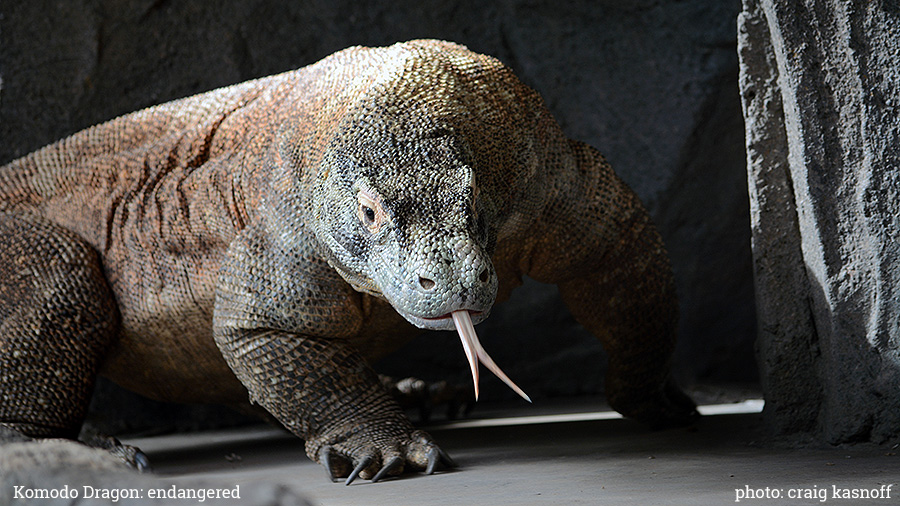
The Komodo Dragon
Name: Komodo Dragon (Varanus komodoensis)
Conservation Status: Endangered (2021 IUCN Red List)
Population Estimate: 1,400 adults
Range: Indonesia (islands of Komodo, Rintja, Padar and Flores)
Threats: Illegal hunting, habitat encroachment, climate change
Conservation Action Needed: Site management, invasive species control, species management, compliance and enforcement
Imagine being shipwrecked on a remote island and finding yourself face-to-face with the world’s largest living lizard — a meat-eating monster up to 12 feet (3.6 m) long, weighing 300 pounds (136 kg)! The first visitors to Komodo Island probably were terrified by these prehistoric-looking beasts when they encountered the Komodo dragon.
The Komodo dragon, or Komodo monitor lizard, is thought to be the source of Chinese legends of great scaly man-eating monsters, the dragons that are still featured prominently in Chinese folklore and religion.
Species Description and Range
The Komodo dragon occurs only on Komodo and its few smaller outlying islands north of Australia (see Spotlight on Island Biogeography). It probably never was more widely distributed, although maps of ancient mariners had notations of “here be dragons” dotted throughout the islands of what is now Malaysia and Indonesia. It was not until the early 1900s that scientists confirmed the existence of these incredible giant lizards.
Natural History of Komodo Dragons
Komodo dragons are carnivores (meat eaters) and will devour any animal they are capable of dismembering and gulping down. Although they are for the most part scavengers, they do capture live prey, including deer, pigs, birds, even young dragons. The young can escape by climbing trees, because the much-heavier adults cannot climb. Komodo dragons are good swimmers and have been reported hunting in the surf for fish and birds.
Komodo dragons are formidable predators, since even one bite can be lethal. The bacteria that live in the dragon’s saliva are so virulent that wounds often will not heal. Even if the victim gets away, it usually dies from infection in a few days. The dragon’s reputation as a human eater is well deserved; it does not seem to fear humans and many attacks and deaths have been reported.
Causes of Endangerment of the Komodo Dragon
Hunting and Habitat Loss
In 2021 the Komodo dragon was listed as Endangered by the IUCN “on the basis that this species occurs in eight subpopulations, with a total adult population estimated to contain fewer than 1,400 individuals, no individual subpopulation contains more than 500 individuals, and climate modelling suggests a rate of decline over 40 years from 2010 which may exceed 30%.” In other words, the Komodo dragon population is small and fragmented and climate change has now also become a factor in its survival.
The Komodo dragon’s limited distribution makes them highly susceptible to natural or human-caused events, such as storms, fire, or disease. The primary threats to the dragon’s survival include illegal hunting and loss of habitat to human settlement. Efforts to smuggle the Komodo dragon out of Indonesia for use in the pet trade have also been recorded.
As was the case with most large, spectacular animals the world over, Komodo dragons have also been sought as trophies by big-game hunters. And they are also killed for skins and feet to make novelties. Early in this century, many Komodo dragons were trapped for sale to zoos and private collectors.
Conservation Actions to Protect the Komodo Dragon
Regulation of Trade and Habitat Protection
Trade in Komodo dragons is prohibited under CITES. Protection from poaching is made easier by the dragon’s limited distribution; there is little human habitation on the islands where it occurs, and Komodo Island, the dragon’s stronghold, has been made a national park.
Tourism
Komodo dragons now are the center of a burgeoning tourist industry, and the local people increasingly are recognizing the advantage of living near this potentially dangerous animal. Because of Komodo Island’s remoteness, visitors to the island must stay in local hotels and hire local guides.
In some areas, the Komodo dragons are so well fed that they simply lie around waiting for the next group of tourists to bring the next meal of goat or sheep.
Question for Thought
Do you think the rise in ecotourism is good or bad for the survival of the Komodo dragon? What negative impacts might island tourists have on the Komodo dragon and its habitat?
Explore:
Related Classroom Activities:
[CS1-1, CS1-4, CS2-1, General]
Click here for Endangered Species Classroom Glossary